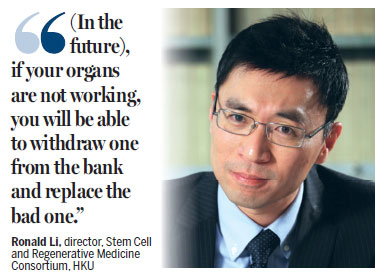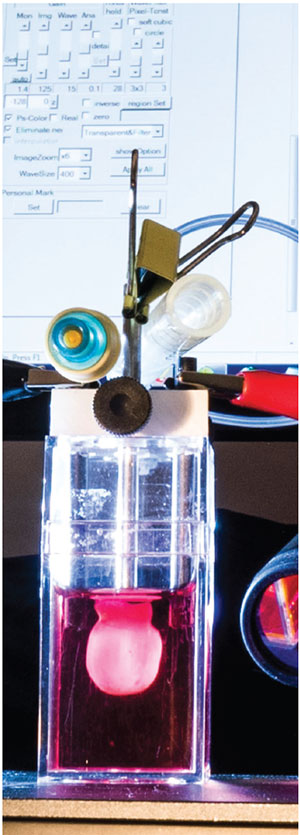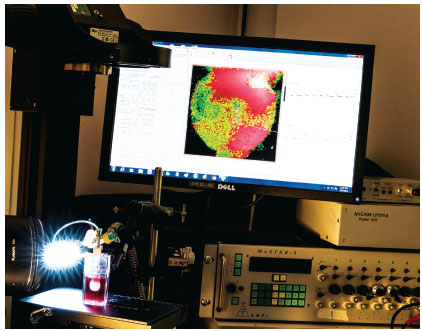Finding a way to mend a broken heart
Updated: 2015-06-17 07:44
By Frannie Guan(HK Edition)
|
|||||||||
Experiments conducted by stem cell technology expert
Ronald Li and his team at HKU might help reduce fatalities in case of a coronary attack in the near future. Frannie Guan reports.
'If I take 2.5 milliliters of blood from you today, you can come back in 12 to 16 weeks and I will show you a mini-heart made from your cells," said Professor Ronald Li, director of Stem Cell and Regenerative Medicine Consortium at The University of Hong Kong Li Ka Shing Faculty of Medicine.
In the incubators at Li's lab, a conical pouch, attached to one end of a stick, was pumping at the rate of a normal human heart (60-100 beats per minute) inside a 10-centimeter-tall cubic container. It was a mini human heart, about the size of that of a human fetus, as Li pointed out.
A heart attack occurs when the flow of oxygen-rich blood to the heart muscles is blocked by clots inside the coronary arteries. A part of the heart muscle becomes irreparably damaged. Most heart attacks occur as a result of coronary heart disease.
Since the 1960s, heart disease has been the third leading cause of death in Hong Kong. Statistics from the Department of Health show that among all heart diseases coronary heart disease is the major cause of death. In 2013, for instance, the number of deaths due to coronary heart disease was 4,007, accounting for 9.2 percent of all deaths.
"Our mini heart is basically a small left ventricle," Li explained. The left ventricle is one of the two large chambers of the heart, responsible for pumping blood almost throughout the body except for the lungs. Li's research focuses on heart attacks and heart rhythm disorders, all of which he said may be considered diseases of the ventricles.
The mini heart Li's team has made was fully capable of pumping blood. "You can even conduct all sorts of measurements, the same as a cardiologist would do for you at a hospital." Li says his team is also working on the next generation mini heart that can be linked to blood vessels, a step closer to producing a complete human heart.
But Li said even before the human heart can be replicated in a clinical laboratory, a simple "patch" would be sufficient to slow down the progression of heart disease. "If we can detect coming heart attacks early on, we do not need to replace the whole heart, we just need to mend it with a bandage," said Li.
Especially potent
Heart cells can't be regenerated on their own. Once they die, they are gone forever. The accelerating death of heart cells finally leads to advanced, chronic conditions such as heart failure, eventually leading to a life risk unless replaced with a donor heart. Often it takes long to find a replacement and there is always a risk that the donor heart may be rejected by the recipient's immune system.
Stem cell technology makes use of human stem cells to produce cells that cannot be naturally regenerated.
There are a billion different types of stem cells in our body. What attracted Li's team was a type called pluripotent stem cells, which Li believes to belong in the elite class of stem cells in the human body.
Pluripotent stem cells, says Li, can help develop any other type of cell in the human body in unlimited numbers.
Back in the 1980s, the only way to harvest pluripotent stem cells was to acquire them from human embryos, resulting in fierce opposition raised on moral grounds, alleging misuse of the technology.
Scientists have now discovered ways to convert ordinary cells such as skin cells into pluripotent cells. The reprogramming of skin cells into stem cells earned Professor Shinya Yamanaka, of Japan's Kyoto University, the 2012 Nobel Prize in Physiology or Medicine.
Li's team used ordinary blood cells as the basis of creating the mini heart. The 2.5 milliliters of blood were mixed into a cocktail in a dish. Within days, the cells were transformed into induced pluripotent stem cells.
To complete the transformation of the stem cells into heart cells, team members added another cocktail to the dish. Within a few days, billions of ventricular cardiac muscle cells had been formed. "We can then put them into a specially designed bioreactor and within a few days, we can get this human heart muscle," said Li.
Each cell type is defined by its pattern of regulated gene expression. The transition of a cell from a certain type to another involves a switch from a certain pattern of gene expression to another. So in order to transform the stem cell into ventricular cells, researchers have discovered a specific recipe or cocktail that causes the change of gene expression.
Li explained the derived heart cells eventually can be used to produce a bio artificial heart patch. "We just need to cover the wound where the heart tissues are dead, and the synthetic patch can repair heart damage at an early stage and stop it from deteriorating."
Over the years, his team had carried out tests on pigs. The reason his lab picked pigs rather than mice is that pigs' hearts are similar to those of human beings, both in appearance and in many biological properties. Li said the results have been satisfactory. The team is closer to moving from animal tests to clinical trials. Li believed that in the not too distant future, there will be banks of bio-artificial organs and tissues. "If your organs are not working, you will be able to withdraw one from the bank and replace the bad one," said Li.
Varying standards
Li said the transplantable heart from the lab could potentially be developed within the next few years. The exact time frame depends on not only the technical improvements, but also the infrastructure and other policy support.
"It is an emerging field," said Li. When it comes to clinical trials, Li says the team hopes to conduct them at high standards to ensure the high quality of the heart or replacement tissue to be placed into the human body. At the moment, there are certain standards for producing clinical-grade cells and they vary in different countries and regions. Li believed the very first step should be to have a universal standard for pluripotent stem cells so that quality can be guaranteed. "The international group, of which Hong Kong is a member, is trying to get it done," said Li.
Li said compared with 15 years ago, when scientists first isolated human embryonic stem cells, the efficiency for developing heart cells now has improved 100 fold. The technological improvements have helped the team to extract more raw materials for their research.
The great hope of the pharmaceutical industry is that one day it will be able to detect both positive and potentially negative effects before trial drugs are tested on humans. And tests will be carried out far more quickly. The invention of the mini heart already provides the industry an efficient method for testing pharmaceutical products.
"Side effects of drugs can be different in different people, because of genetic differences." Li explained that traditional drug trails examined only one drug at a time and the process could take years at a cost of $1 billion or more. Once the heart is capable of replication in the lab, thousands of drug candidates could be tested at the same time, substantially reducing the costs.
The Stem Cell and Regenerative Medicine Consortium at the University of Hong Kong started in 2010 when the university wanted to catch the wave of stem cell technology research. Earlier Li was a tenured associate professor at the University of California, where he led the Human Embryonic Stem Cell Consortium. Li started his career in the field at the Johns Hopkins University.
Over the years, Li's team not only established cooperation with Johns Hopkins University, but also some other leading institutes in stem cell technology, such as Harvard University, Stanford University, and also the Chinese Academy of Sciences.
Contact the writer at frannie@chinadailyhk.com

|
A bio-artificial human cardiac ventricular chamber draws oxygen from the red nutritious liquid through pumping. |
|
The mini heart crafted from ventricular heart muscle cells is being read for electrocardiogram signals. photos by novoheart ltd |
(HK Edition 06/17/2015 page9)

 3
3